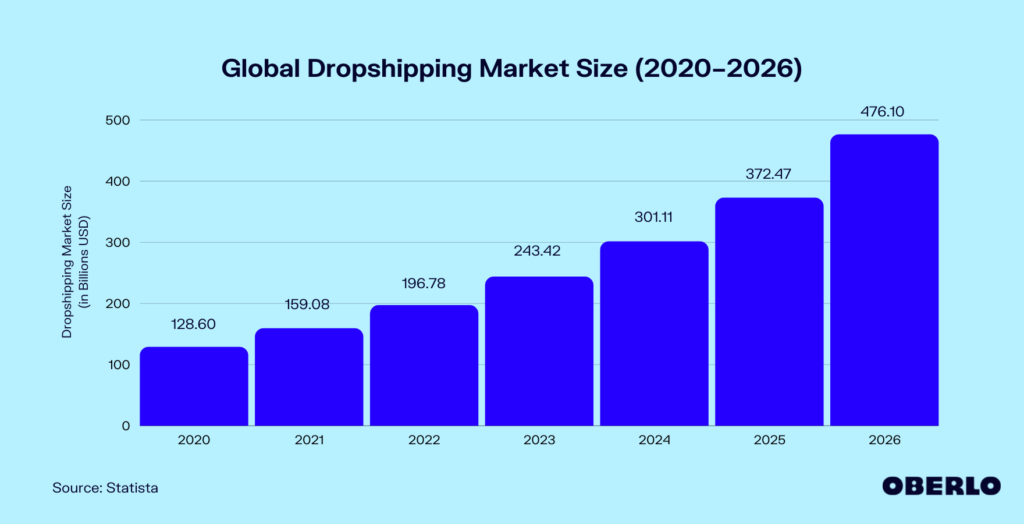I was captivated when I stumbled upon the concept of earning money even as I slept. The vision of sipping a coffee early in the morning, browsing my dashboard, and discovering that I made sales overnight was thrilling. And as I delved deeper into this world, drop-shipping continually emerged as a beacon of possibility.

With the dawn of the digital age, there's been an undeniable shift in the way we shop. Here's a staggering fact: In 2021, over 2.14 billion people worldwide purchased goods online. This impressive statistic sheds light on the immense potential waiting in the realm of e-commerce.
Now, let's dive into drop-shipping. At its core, drop-shipping is an e-commerce strategy where you, the store owner, don't physically stock the products you're selling. Instead, when a customer places an order, you buy the product from a third-party supplier who then ships it directly to the customer. Sounds straightforward, right? But the true appeal lies in the minimal upfront investment, reduced risk, and the potential for scalable profits. To underscore its significance, consider this: according to a report by BigCommerce, drop-shipping was responsible for nearly 23% of online sales in recent times. Such figures showcase the undeniable traction this model has gained.
Understanding Drop-shipping: The Basics
Before venturing into the intricate world of drop-shipping, it's pivotal to grasp its foundational principles. Let's embark on this enlightening journey together!
What is drop-shipping?
Drop-shipping is a retail fulfillment model where a store doesn't keep the products it sells in stock. Instead, when you, the store owner, receive an order, you purchase the product from a third party—usually a wholesaler or manufacturer—and have it shipped directly to the customer. This means that you never see or handle the product yourself. You act as a middleman, managing the customer relationship and handling the sales aspect, while your supplier takes care of product storage, packaging, and shipping.

Key benefits and challenges
The benefits of drop-shipping are numerous:
- Low Startup Costs: Without the need for inventory, the initial investment is much lower compared to traditional retail models.
- Flexibility: Manage your business from anywhere with an internet connection. Plus, explore a diverse range of products without committing to inventory.
- Scalability: Easily adjust to the ebb and flow of demand without the concerns of overstock or wasted products.
However, with the pros come the challenges:
- Lower Profit Margins: As a middleman, you'll often find yourself earning less per sale compared to traditional retailers.
- Inventory Issues: Relying on third-party suppliers can sometimes result in stock shortages or delays, affecting customer satisfaction.
- Less Control: Product quality, shipping times, and inventory are largely out of your hands, which can be a double-edged sword.
Fun fact: Drop-shipping accounted for nearly 23% of online sales in recent years. This stat underscores just how popular and significant this business model has become in e-commerce.

Choosing the Right Platform for Your Store
When it comes to starting a drop-shipping business, one of the most crucial decisions you'll make is selecting the right platform. It serves as the backbone of your operations and can significantly impact your business's success. So, where do you start?
Criteria to Consider
- Cost: What's your budget? Factor in monthly fees, transaction fees, and any additional costs that might arise.
- Customization: Will you have the freedom to design your store as you envision? The degree of flexibility varies across platforms.
- Payment Gateways: It's essential to offer multiple payment options for your customers. Does the platform support your desired gateways?
- Integration Capabilities: The ability to integrate with various apps and tools can streamline your business operations and enhance user experience.
Spotlight on Popular Platforms
Shopify
Shopify is a heavyweight in e-commerce, renowned for its user-friendly interface and rich feature set. It offers a plethora of themes, ensuring that your store looks top-notch. Additionally, with its vast app ecosystem, you can easily enhance your store's capabilities.
Noteworthy statistic: Shopify powers over 1 million businesses worldwide. This insight underscores its popularity and reliability in the e-commerce domain.
WooCommerce
If you're already familiar with WordPress, WooCommerce might be your go-to choice. It's a free plugin that turns your WordPress site into a fully functional e-commerce store. Its standout feature? Flexibility. You can customize every aspect of your store and integrate it seamlessly with countless plugins available in the WordPress ecosystem.
BigCommerce
For those looking to scale big and fast, BigCommerce stands out. It offers a suite of enterprise-grade features right out of the box. It's designed to support rapid business growth from advanced SEO tools to multi-channel selling. It boasts a robust API, ensuring smooth integrations with your preferred tools and services.
Tips on Making a Decision
Now that you're familiar with some top contenders, how do you choose? Begin by assessing your business size and goals:
- Small Startups: If you're starting small, a platform with minimal costs and an intuitive setup, like Shopify, might be ideal.
- Medium Enterprises: A business with more products and traffic might lean towards WooCommerce for its flexibility or BigCommerce for its scalability features.
- Custom Needs: If your business has unique requirements, opting for a platform that offers extensive customization and integration capabilities is crucial.
Remember, your chosen platform should align with your vision and offer the tools you need to thrive. Do your research, consider your long-term goals, and make an informed choice.
Partnering with Reliable Suppliers
Embarking on a drop-shipping venture can feel like setting sail on vast seas. And in this journey, your suppliers are the wind in your sails. Partnering with reliable suppliers isn't just a recommendation; it's the linchpin of a successful drop-shipping business.
Here's why:
The Importance of Trustworthy Suppliers
In the drop-shipping model, your direct control over inventory and shipping is relinquished. Instead, your reputation hinges on third-party suppliers. If they falter, it's your brand name that's at stake. From the timely dispatch of products to their quality, a trustworthy supplier ensures your customers get what they expect when they expect it.
Spotlight on Popular Platforms
AliExpress
Renowned for its vast assortment of products and manufacturers, AliExpress is a favorite among many drop-shippers. However, while its diversity is a strength, it can also be a drawback as quality can vary significantly between suppliers.
- Pros: Extensive product range, no upfront fees, and direct access to Chinese manufacturers.
- Cons: Longer shipping times, potential quality inconsistencies, and occasional communication barriers with suppliers.
Oberlo
Oberlo, primarily a bridge between Shopify and AliExpress, streamlines product import and order management for drop shippers. It offers a curated list of suppliers, adding a layer of trustworthiness.
- Pros: User-friendly interface, integration with Shopify, and supplier performance ratings.
- Cons: Limited to Shopify and AliExpress, potential markups in prices.
SaleHoo
SaleHoo, a global drop-shipping directory, connects retailers to vetted suppliers. With its focus on
Crafting an Outstanding Customer Experience
Drop-shipping or not, at the heart of every successful e-commerce venture is an unforgettable customer experience. While you might not have control over every facet of the supply chain in drop-shipping, you can do plenty to ensure your customers keep coming back.
Personalizing the Shopping Experience
The days of one-size-fits-all shopping experiences are long gone. Today's customers crave personalization. They want to feel valued, understood, and catered to. Whether it's through tailored product recommendations, personalized email campaigns, or dynamic website content, adding that personal touch can significantly elevate the shopping experience. Tools like dynamic retargeting can also be a game-changer, showing customers products they've shown interest in and creating a sense of familiarity and personal care.
Managing Customer Expectations
Transparency is key. In the drop-shipping world, where shipping times can vary and returns might be complicated, it's paramount to set clear expectations. Here's how:
- Clear Shipping Policies: Clearly state shipping times, costs, and any other pertinent information. If shipping might take longer due to the supplier's location, be upfront about it.
- Transparent Return Policies: Ensure your return policies are easily accessible and understandable. While you're at it, make sure they're fair too. A fair return policy can be a significant trust builder.
Engaging with Customers Post-Purchase
You've made the sale, hooray! But the journey doesn't end there. Engaging with customers after they've made a purchase can be the key to building long-term loyalty. After all, studies show that acquiring a new customer can cost five times more than retaining an existing one. Here are some tactics:
- Thank You Emails: A simple gesture that goes a long way. Show your gratitude and perhaps offer a discount on their next purchase.
- Feedback Surveys: Invite them to share their shopping experience. It shows you value their opinion and gives you invaluable insights.
- Loyalty Programs: Reward your frequent shoppers with discounts, early access to new products, or other exclusive perks.
At the end of the day, the key is to show your customers that you care. Be it through personalization, transparency, or post-purchase engagement, a little effort can go a long way in crafting an outstanding customer experience.
Marketing Your Drop-shipping Store
The success of your drop-shipping store isn't just about choosing the right products or reliable suppliers—it's also about getting the word out and attracting customers. Let's explore the avenues you can tap into to drive traffic and sales.
The Significance of Organic Traffic and SEO
Imagine opening a physical store in the heart of a bustling city as opposed to a desolate alley. The difference is foot traffic. In the digital world, this foot traffic is organic search traffic, and the bustling city is the front page of search engine results. By optimizing your store for search engines (a practice known as SEO), you're essentially setting up shop where the crowd is. Proper keyword research, high-quality content, and backlink strategies can all contribute to a higher search engine ranking, drawing in potential customers without an additional ad spend.
Personal Tip on Leveraging Social Media Effectively
When I began promoting content on social media, I quickly realized that it's not about being everywhere but rather about being impactful where you are. Choose one or two platforms where your target audience hangs out the most. Dedicate your time to creating valuable content, engaging with your audience, and being authentically you. Visually appealing platforms like Instagram and Pinterest proved invaluable for my drop-shipping venture. Showcasing products through high-quality images or creating pin-worthy infographics can do wonders for engagement and traffic.
Paid Advertisements: Platforms and Strategies
Paid advertising can provide a significant boost, especially when you're looking to gain momentum. Platforms like Google Ads and Facebook Ads offer targeted marketing options to reach specific demographics. The key here is to:
- Set Clear Objectives: Whether it's brand awareness, website traffic, or conversions, know your goal.
- Segment Your Audience: Tailor your ads based on age, interests, location, and other criteria.
- Optimize and Iterate: Regularly review your ad performance. Refine your strategies based on data, not hunches.
Case Study: The Power of Video Marketing
With the rise of platforms like TikTok and YouTube, the power of video marketing has never been more evident. But did you know that brands adopting video marketing witness a 49% faster growth in revenue? This isn't just a flashy statistic. Videos can provide an immersive experience, showcasing your products in action and building a stronger emotional connection with potential customers. If you're not already incorporating video into your marketing strategy, now might be the time to start.
Whether you're diving into SEO, social media, paid ads, or video marketing, remember to stay authentic, engage with your audience, and always be ready to learn and adapt.
Addressing Common Challenges and Solutions
In the drop-shipping world, the ride isn't always smooth. Like any business model, there are inevitable challenges along the way. But, with a proactive mindset and equipped with the right strategies, these hurdles can be transformed into growth opportunities. Let's discuss some of these challenges and how to tackle them head-on.
Managing Out-of-Stock Situations
One of the trickier aspects of drop-shipping is inventory management. Since you're not stocking the products yourself, it's possible to face situations where a customer orders a product that's out-of-stock with your supplier.
- Open Communication: Notify the customer promptly about the situation, apologize, and offer alternatives. Honesty builds trust.
- Inventory Alerts: Use tools or software that sync with your supplier's inventory and alert you of low-stock items. This way, you can update your product listings in real time or pause promotions for those items.
- Diversify Suppliers: Consider having multiple suppliers for popular products. If one runs out, you can fulfill the order through another.
Handling Returns and Disputes
Returns are a part and parcel of e-commerce. However, drop-shipping can get a tad more complicated as you're not the direct shipper.
- Clear Return Policy: Have a well-defined and transparent return policy on your website. This not only manages customer expectations but can also minimize disputes.
- Mediation: In the event of a dispute, play an active role in mediating between the customer and the supplier to find a satisfactory resolution.
- Quality Control: Regularly review and assess the quality of products from your suppliers. High-quality products can naturally lead to fewer returns.
Adapting to Market Shifts and Staying Updated
The online marketplace is dynamic. Trends come and go, and consumer preferences shift rapidly. For a drop-shipper, staying adaptable is key.
- Regular Market Research: Stay updated with industry news, emerging trends, and competitor activities. Platforms like Google Trends can offer insights into popular products or niches.
- Feedback Loop: Regularly collect feedback from your customers. They can offer valuable insights into product preferences or potential improvements.
- Continued Learning: The e-commerce and drop-shipping landscape is ever-evolving. Participate in webinars, online courses, and workshops to keep your knowledge sharp.
While the drop-shipping path presents its unique challenges, with the right strategies and a proactive approach, you can navigate these waters with confidence and grace. Remember, every challenge faced is a lesson learned and an opportunity for growth.
Conclusion
With its unique blend of e-commerce and entrepreneurship, drop-shipping has truly cemented its place as a viable passive income stream in the modern age. Its beauty lies not just in its flexibility but also in the endless possibilities it presents. From choosing a niche to establishing relationships with suppliers, every step can be a rewarding experience.
Reflecting on my own journey, I've realized that the thrill of entrepreneurship isn't just in the successes but also in the challenges and the learning that comes with them. Each hiccup, each unexpected turn, has only added depth to my entrepreneurial story, making it richer and more fulfilling.
And to you, dear reader, if there's one thing I'd like you to take away, it's this: Starting truly is half the battle. The world of drop-shipping, with its ups and downs, awaits you. Embrace it with an open heart, a curious mind, and the resilience to push through challenges. Your entrepreneurial story is waiting to be written. Here's to the adventures ahead!










